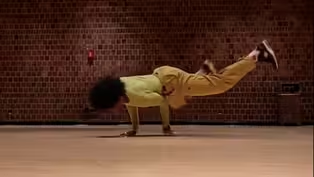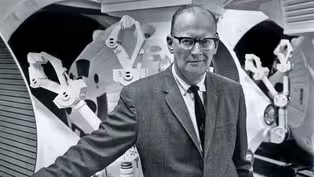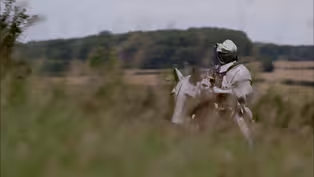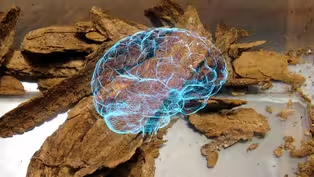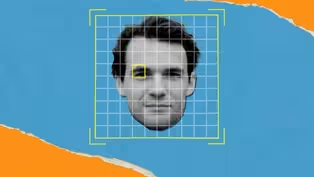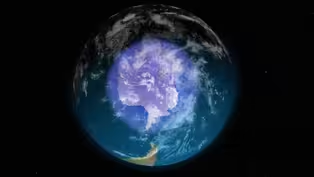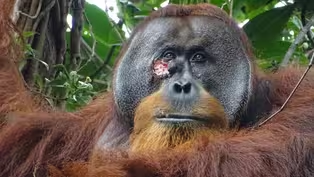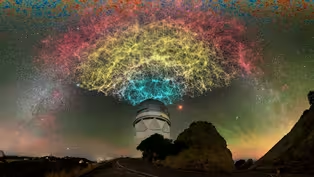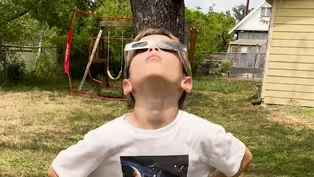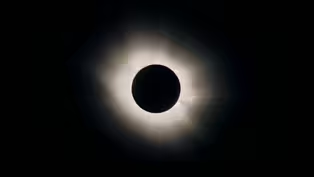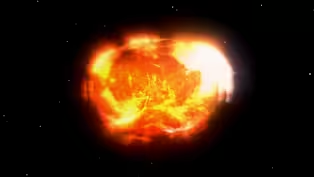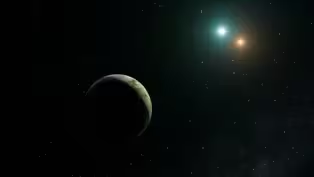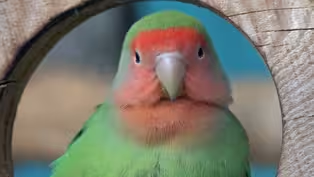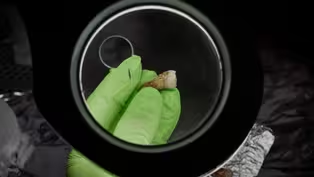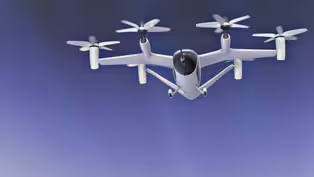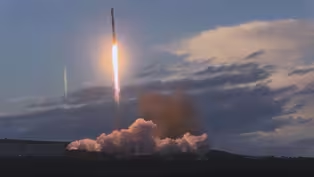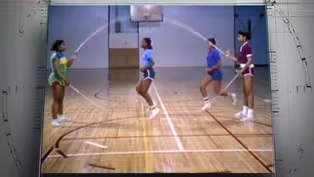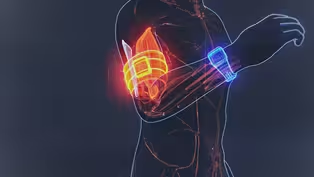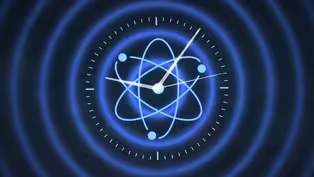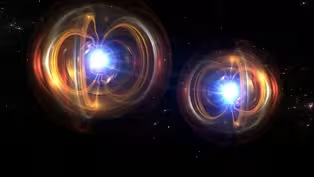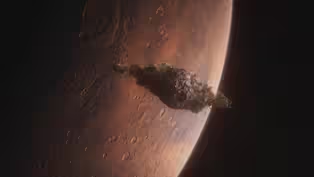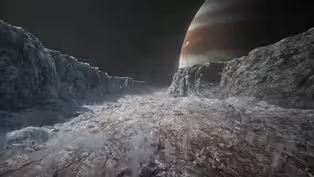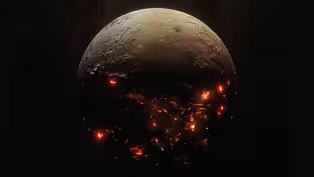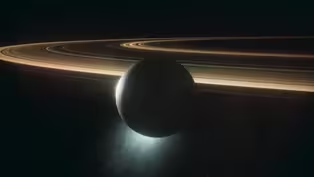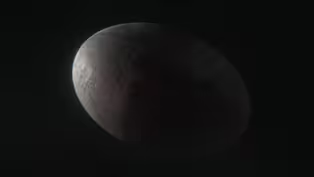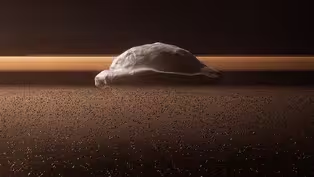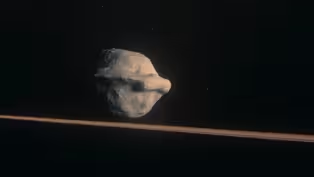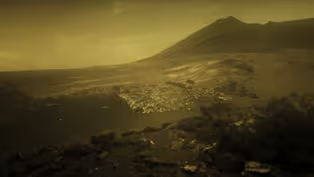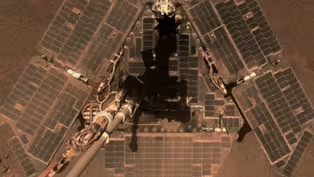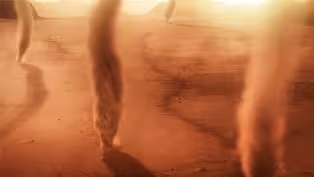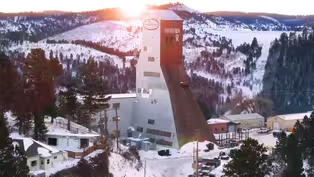
What Happens to Your Body During a Speed Eating Competition?
Clip: Season 51 | 5m 16sVideo has Closed Captions
Competitive eaters stretch their stomachs beyond limits. Here’s what happens inside their bodies.
Competitive eaters train to stretch their stomachs far beyond normal limits, allowing them to consume massive amounts of food in minutes. But this extreme practice takes a toll on the body. Here’s how they do it - and what happens inside their bodies.
Problems playing video? | Closed Captioning Feedback
Problems playing video? | Closed Captioning Feedback
National Corporate funding for NOVA is provided by Carlisle Companies and Viking Cruises. Major funding for NOVA is provided by the NOVA Science Trust, the Corporation for Public Broadcasting, and PBS viewers.

What Happens to Your Body During a Speed Eating Competition?
Clip: Season 51 | 5m 16sVideo has Closed Captions
Competitive eaters train to stretch their stomachs far beyond normal limits, allowing them to consume massive amounts of food in minutes. But this extreme practice takes a toll on the body. Here’s how they do it - and what happens inside their bodies.
Problems playing video? | Closed Captioning Feedback
How to Watch NOVA
NOVA is available to stream on pbs.org and the free PBS App, available on iPhone, Apple TV, Android TV, Android smartphones, Amazon Fire TV, Amazon Fire Tablet, Roku, Samsung Smart TV, and Vizio.
Buy Now

NOVA Labs
NOVA Labs is a free digital platform that engages teens and lifelong learners in games and interactives that foster authentic scientific exploration. Participants take part in real-world investigations by visualizing, analyzing, and playing with the same data that scientists use.Providing Support for PBS.org
Learn Moreabout PBS online sponsorship- [Host] What's it like to eat 58 hot dogs in ten minutes?
- I mean, it is kind of fun.
I think one time I gained like 25 pounds in ten minutes.
I dunno if it's fun, but it's kind of insane to think about it.
- [Host] So what happens inside the bodies of competitive eaters as they tackle pounds of food in just minutes?
- The stomach has a fascinating organ.
It's really two organs in one.
The top part of the stomach is a receptacle and the bottom part of the stomach is a grinder.
- [Host] When food lands in the upper part of the stomach, the stomach naturally relaxes and expands.
The pressure on the other organ sends a signal to the brain, "I'm full and need to burp."
This is your body signal that you should stop eating.
Competitive eaters can dramatically relax and stretch their stomachs.
That stretching allows them to eat more without feeling full and they also train themselves to push past the feeling of fullness.
- The speed eater just has a bigger capacity at complete relaxation and a less of a stimulus to, "I'm feeling full and I need to stop."
- [Host] This is where the speed eater's unique ability comes into play.
- The way we look at the stomach, it's just like a big muscle and I think a resting stomach of an above average eater can maybe hold three quarters of a gallon or six to eight pounds, but we can hold sizeably more than that.
- [Host] The ability to expand the stomach is likely a combination of innate ability and dedicated training.
- But it's similar to somebody who might have a genetic tendency towards sprinting or towards marathoning.
They have muscle fiber types that might lend themselves to either races that are intense and short and super fast, or long and steady.
However, you can't get to the elite class of either kind of races without training.
- So the normal preparation for competitions is practice with the food, which sounds good, but it's not great.
And then you just drink a large amount of liquid to try to expand your stomach.
- You have to always be trying to get a little bit more food in than you could in the past.
That's the only way to really grow.
- [Host] Even with training and innate physiological advantages, the most seasoned speed eater will get tired during a competition.
- You do a contest, it may only be eight minutes, it may only be ten or 12.
It doesn't sound like a lot of time, but when you're spending that entire time just shoveling food down at a really quick rate, it feels like a marathon.
- It is really taxing on the body and a lot of the times, you're just really pushing your body to the limit and you end up like sweating a lot, which is a little odd because you're eating, but it is pretty physical.
- [Host] So what happens in the body when you put that much strain on it?
Typically as food moves into the lower part of the stomach, it mixes with gastric juices and then gradually empties into the small intestine; a process that usually takes about four hours.
But experts say that consuming larger quantities of food at a time may complicate digestion.
- Undigested matter can stay in the gastrointestinal tract for days, disrupting the gut microbiome.
For example, there's risk of small intestinal bacterial overgrowth, abdominal pain and diarrhea, and associated symptoms.
- [Host] Consuming massive amounts of food in a short period can also cause it to sit in the esophagus as it waits to enter the top part of the stomach.
The food piled up can cause vomiting or suffocation.
It may also cause longer term harm to the esophagus and the stomach.
- If you get a tremendous expansion and rupture, you can actually rupture and tear the esophagus, which is called a Boerhaave Syndrome, in which case all those contents leak into the chest and become septic, and it can be really dangerous.
In theory, I think you could potentially rupture the stomach if you just stretch it out far enough.
- [Host] Research on how much the stomach and esophagus can stretch, and whether the stomach can fully return to its original size, is limited.
Scientists are uncertain but they're concerned about permanent loss of stomach elasticity.
- The stomach will relax and expand, and now the question is, can the stomach un-relax and sort of get back to its normal size?
Can those muscles get damaged so much that they don't work properly?
- [Host] If those muscles are permanently damaged, it could cause a disorder called gastroparesis.
This essentially means the stomach muscles are paralyzed, leading to issues like poor digestion, bloating and acid reflux.
To counteract the short-term effects of speed eating, some competitive eaters may try to eat healthy foods, exercise regularly or fast before and after competitions.
Still, participating in training and events does often take a toll on metabolism, muscle health and the body's ability to recognize the feeling of fullness.
- The day after a contest, because you have just had that giant stretch, it is really hard to feel full after that with a normal meal.
And so that part is a lot of like, training your brain to stop eating at a normal time even though you have no sensation of fullness for like, the next week or so.
'Cause you've stretched that out and it's gotta kind of bounce back to normal.
- Through the years, my hunger and my metabolism has definitely slowed down, but I think it's all been pretty relative.
- [Host] Whether or not it takes a lasting toll, competitive eating is certainly extreme.
- I don't think it's terribly unhealthy, but I don't think it's something that I personally would recommend.
I play golf.
(gentle music) - You're still here?
You must really like what you just saw.
If you really did like it that much, take a look at the channel memberships we have.
You can get custom emojis and badges, access to content before it releases, members-only invites to live events and more.
And the money you give actually comes back here to Nova so we can keep making this amazing content for you.
Click the join button now to check it out.
Thanks for watching Nova, and see you again next time.
The Physics of Breaking, a New Olympic Sport
Video has Closed Captions
Clip: S51 | 1m 19s | Here are three moves in breaking, the newest Olympic sport, that appear to defy the laws of physics. (1m 19s)
What Happens to Your Body During a Speed Eating Competition?
Video has Closed Captions
Clip: S51 | 5m 16s | Competitive eaters stretch their stomachs beyond limits. Here’s what happens inside their bodies. (5m 16s)
Flight Turbulence Is Actually Getting Worse
Video has Closed Captions
Clip: S51 | 1m 48s | It’s not all in your head - flights really are bumpier these days. (1m 48s)
Sir Arthur C. Clarke's Vision of the Computer-Dominated Future
Video has Closed Captions
Clip: S51 | 1m 39s | Watch this interview with Sir Arthur C. Clarke for The Mind Machine (1978.) (1m 39s)
How Medieval Armorers Made Knights Bulletproof
Video has Closed Captions
Clip: S51 | 2m 15s | Knights and firearms clashed on the battlefield for over 200 years. (2m 15s)
Video has Closed Captions
Clip: S51 | 1m 2s | Hurricanes are getting more intense, faster. (1m 2s)
This Powerful Psychedelic May Help Treat Opioid Addiction
Video has Closed Captions
Clip: S51 | 3m 28s | In recent decades, there's been renewed interest in studying ibogaine. (3m 28s)
Can Technology Detect Deepfakes Better Than Humans Can?
Video has Closed Captions
Clip: S51 | 7m 9s | AI-generated photos are video are getting so good that it’s hard for humans to tell what’s real. (7m 9s)
What Happened to the Hole in the Ozone Layer?
Video has Closed Captions
Clip: S51 | 3m 13s | In the 1980s scientists discovered a crucial part of the Earth’s atmosphere was extremely thin. (3m 13s)
A Hidden Cause of Sinkholes Is Lurking Underground
Video has Closed Captions
Clip: S51 | 2m 21s | About 40% of the U.S. is susceptible to sinkholes. (2m 21s)
Ozempic's Surprising Real Power
Video has Closed Captions
Clip: S51 | 3m 51s | Blockbuster drug Ozempic keeps surprising scientists. (3m 51s)
What Dating Apps Know About You
Video has Closed Captions
Clip: S51 | 2m 51s | You might be collecting matches, but dating apps are collecting your data. (2m 51s)
These cheeses are at risk of going extinct
Video has Closed Captions
Clip: S51 | 1m 11s | The culprit is a lack of microbial biodiversity in the mold used to make iconic French cheeses. (1m 11s)
First ape ever seen using medicinal plant to treat wound
Video has Closed Captions
Clip: S51 | 1m 58s | After this orangutan sustained a gnarly facial wound, he did something kind of human-like. (1m 58s)
Total Eclipse in the Heart of Texas Hill Country
Video has Closed Captions
Clip: S51 | 6m 41s | People from all over the country converge on a small Texas town to see a total solar eclipse. (6m 41s)
New map of the universe hints that dark energy may be evolving
Video has Closed Captions
Clip: S51 | 3m | Dark energy fundamentally shapes our universe and what astronomers know about it might be wrong. (3m)
Are winters getting less snowy?
Video has Closed Captions
Clip: S51 | 4m 49s | It’s not just your imagination, winters across the U.S. are changing. (4m 49s)
How America watched the solar eclipse
Video has Closed Captions
Clip: S51 | 2m 13s | Millions witnessed the Moon cover the Sun on April 8, some viewers sent us their videos. (2m 13s)
How to watch the eclipse without burning your eyes
Video has Closed Captions
Clip: S51 | 1m 59s | A total solar eclipse is coming. If you want to check it out, you need eye protection. (1m 59s)
Rare stellar explosion will ignite a "new star"
Video has Closed Captions
Clip: S51 | 1m 17s | Sometime between now and September a star will explode. (1m 17s)
The discovery of worlds beyond our solar system
Video has Closed Captions
Clip: S51 | 1m 39s | How did we discover exoplanets? (1m 39s)
The force that makes up more than half of the universe
Video has Closed Captions
Clip: S51 | 1m 40s | Dark Energy was first discovered in 1998, and scientists don’t fully understand it. (1m 40s)
How parrots swing like monkeys
Video has Closed Captions
Clip: S51 | 1m 36s | Like monkeys, parrots are also able to travel by suspending their body weight. (1m 36s)
Who is the Mystery Man Buried Under Notre Dame?
Video has Closed Captions
Clip: S51 Ep18 | 3m | Can scientists identify the man buried inside a mysterious coffin found under Notre Dame? (3m)
Lost Tombs of Notre Dame Preview
Video has Closed Captions
Preview: S51 Ep18 | 30s | Mysterious bodies are found under one of the world’s most famous cathedrals. (30s)
Building Stuff: Change It! Preview
Video has Closed Captions
Preview: S51 Ep17 | 30s | From electric flight to artificial noses, engineers are finding new ways to preserve our planet. (30s)
Building Stuff: Reach It! Preview
Video has Closed Captions
Preview: S51 Ep16 | 30s | Humans are born to roam. See how engineers are inventing new ways to explore and extend our range. (30s)
Creating a Robotic Double Dutch Machine
Video has Closed Captions
Clip: S51 Ep15 | 5m 8s | Blending innovation and culture, engineers bring a robotic Double Dutch machine to life. (5m 8s)
Building Stuff: Boost It! Preview
Video has Closed Captions
Preview: S51 Ep15 | 30s | Is engineering humanity’s superpower? See how we can amplify our natural abilities in amazing ways. (30s)
The Most Baffling Idea in Physics, Explained
Video has Closed Captions
Clip: S51 Ep14 | 3m 33s | Quantum entanglement defies our everyday understanding of reality. (3m 33s)
How Atomic Clocks Keep Perfect Time
Video has Closed Captions
Clip: S51 Ep14 | 2m 15s | Atomic clocks use quantum physics and the resonant frequency of atoms, like cesium, to define time. (2m 15s)
Decoding the Universe: Quantum Preview
Video has Closed Captions
Preview: S51 Ep14 | 30s | Dive into the universe at the tiniest – and weirdest – of scales. (30s)
Solar System: Wandering Worlds Preview
Video has Closed Captions
Preview: S51 Ep13 | 30s | Meet the surprising, oddball worlds moving around our solar system. (30s)
Could Mars Have a Ring Around It One Day?
Video has Closed Captions
Clip: S51 Ep13 | 2m 16s | The moon Phobos has a mysterious origin but a certain expiration date. (2m 16s)
Cameras Capture Earthbound Meteorite
Video has Closed Captions
Clip: S51 Ep13 | 1m 39s | Some large meteorites survive their descent through our atmosphere and land on Earth. (1m 39s)
Video has Closed Captions
Clip: S51 Ep12 | 55s | As comets cross the invisible boundary known as the ice line, their ice starts turning into gas. (55s)
This Moon May Have the Ingredients for Life
Video has Closed Captions
Clip: S51 Ep12 | 2m 14s | The ocean beneath Europa’s icy shell might be an ideal environment for life. (2m 14s)
Solar System: Icy Worlds Preview
Video has Closed Captions
Preview: S51 Ep12 | 30s | Visit strange, frozen worlds to discover the bizarre ice that forms beyond Earth. (30s)
This Tiny Moon Is a Volcanic Powerhouse
Video has Closed Captions
Clip: S51 Ep11 | 2m 45s | Io’s intense volcanic activity defies all expectations. (2m 45s)
Solar System: Volcano Worlds Preview
Video has Closed Captions
Preview: S51 Ep11 | 30s | Discover the powerful volcanic eruptions that have shaped worlds across our solar system. (30s)
Enceladus: A Frozen Moon With Explosive Eruptions
Video has Closed Captions
Clip: S51 Ep11 | 1m 56s | Enceladus’ small size and icy surface is no limitation to its extreme volcanism. (1m 56s)
Could This Icy Moon’s Ocean Support Life?
Video has Closed Captions
Clip: S51 Ep11 | 1m 21s | Hydrothermal vents in Enceladus’ ocean may hold the promise of life. (1m 21s)
Why is Haumea Shaped Like an Egg?
Video has Closed Captions
Clip: S51 Ep10 | 2m 30s | Most objects with a radius over 200 miles are spherical, but Haumea is an exception. (2m 30s)
Solar System: Strange Worlds Preview
Video has Closed Captions
Preview: S51 Ep10 | 30s | What are the weirdest worlds in our solar system, and how did they come to be? (30s)
How a Walnut-Shaped Moon Help Shape Saturn’s Rings
Video has Closed Captions
Clip: S51 Ep10 | 2m 35s | For millions of years, a tiny moon has made a significant impact on the structure of Saturn’s rings. (2m 35s)
Venus: The Planet With Battery Acid Clouds
Video has Closed Captions
Clip: S51 Ep9 | 3m 27s | This is what it would be like to walk on the surface of Venus. (3m 27s)
How the Martian Atmosphere Helped Nasa’s Rovers Restore Energy
Video has Closed Captions
Clip: S51 Ep9 | 2m 59s | Martian dust devils may have helped NASA’s rovers restore power during mission. (2m 59s)
Solar System: Storm Worlds Preview
Video has Closed Captions
Preview: S51 Ep9 | 30s | Discover the dramatic forces creating spectacular weather on neighboring planets and moons. (30s)
How Vera Rubin broke barriers in astronomy
Video has Closed Captions
Clip: S51 Ep8 | 4m 4s | Vera Rubin's work provided convincing evidence for a mysterious substance, dark matter. (4m 4s)
The Deepest Underground Lab in the U.S.
Video has Closed Captions
Clip: S51 Ep8 | 1m 44s | A team of researchers hunt for dark matter deep underground in the Black Hills of South Dakota. (1m 44s)
Providing Support for PBS.org
Learn Moreabout PBS online sponsorship
- Science and Nature

Capturing the splendor of the natural world, from the African plains to the Antarctic ice.

- Science and Nature

Learn how centuries of knowledge helped our ancestors understand the mysteries of space.












Support for PBS provided by:
National Corporate funding for NOVA is provided by Carlisle Companies and Viking Cruises. Major funding for NOVA is provided by the NOVA Science Trust, the Corporation for Public Broadcasting, and PBS viewers.


